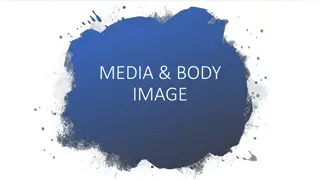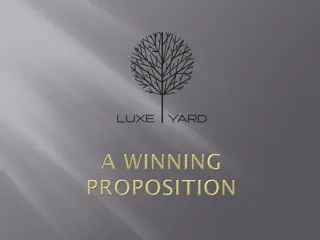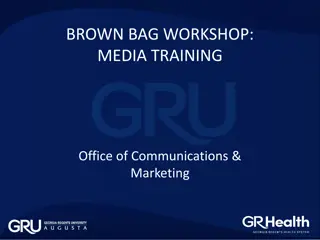Crafting a Strong Rationale for Media Outlet Selection in COMM2079
Understand the essence of crafting a strong rationale in COMM2079 by selecting 5 media outlets for your story. Learn to apply critical thinking, media theories, and demonstrate your understanding of key concepts to match audience demographics effectively. Explore examples and guidelines to enhance your decision-making process.
Download Presentation

Please find below an Image/Link to download the presentation.
The content on the website is provided AS IS for your information and personal use only. It may not be sold, licensed, or shared on other websites without obtaining consent from the author.If you encounter any issues during the download, it is possible that the publisher has removed the file from their server.
You are allowed to download the files provided on this website for personal or commercial use, subject to the condition that they are used lawfully. All files are the property of their respective owners.
The content on the website is provided AS IS for your information and personal use only. It may not be sold, licensed, or shared on other websites without obtaining consent from the author.
E N D
Presentation Transcript
Writing a strong rationale COMM2079
What is a rationale? An articulation or explanation of the reasons for doing something. In Assessment 1, you have to write a rationale for selecting the 5 media outlets that will be interested in your story (presented in the media release) An academic discussion Demonstrating a critical level of thought Incorporating relevant media theories Citing where appropriate 2
Points to consider when writing a rationale What is the media release about? Why did you choose the 5 media outlets? What is the link between the story in the media release and the outlets? What are some of the media theories that directed your choice of media outlets? How do the choices you have made demonstrate your understanding of the concepts and theories that have been introduced? How do the choices you have made demonstrate critical reading of the material for this course?
An example of media outlets Audience: women 18-50 across the Gold Coast community. This outlet is a trusted source for local events and culture. Attention: Catherine Webber, Editor Targeted towards an article in the surfing news, beaches or lifestyle sections of both print and online. 1. Gold Cost Bulletin Audience: business owners, entrepreneurs and people interested in inspirations stories and new ventures or events. Attention: Tara Francis, Features Editor Lead times tailor towards a feature articles in a future monthly edition. 2. Collective Magazine Audience: target demographics that listen to contemporary music and local news for coastal regions. Attention: Andrew Very, Content Director Aimed towards study during news or surf reports. 3. SEA FM Audience: popular TV news for locals including online sources Attention: Rod Power, Gold Coast News Director A story during news bulleting and online. 4. Nine Gold Coast News Audience: fashion and culture conscious woman from Byron Bay to Brisbane Attention: Logan Smith, Editor Due to lead times, targeted for feature, also for future events listed in upcoming editions. 5. Gold Coast Magazine
An example of rationale for the identified media outlets The author has based their reasons on evidence. They have demonstrated that they understand the concepts that were introduced in course. Their choice of the outlets were directed by their readings. The audience groups identified in the five media outlets match that of Mazarine Aqua including key demographics, lifestyle interests and proximity, which is key to successful planning (Bivins 2014, p.35). The selection of outlets was curated to provide coverage over a number of mediums, timeframes and include current and potential public. Reflection on Framing Theory provided guidance for selecting outlets based on news-values and tailoring the newsworthiness of the release to suit (Johnston & Sheehan 2014, p. 401). Agenda Setting Theory is relevant when considering the transfer of a story s importance from media to the public based on what media consider news; the public then form an interest (Chia & Synnott 2009, p. 16) The author has also demonstrated that they understand the different media theories that were introduced in the course by using them to justify their selection of the outlets Therefore, it is important to select media outlets that find the story newsworthy for a greater chance of coverage. Narrative Theory suggests that organisational identities are created via their stories and positive stories can be persuasive (Johnston & Sheehan 2014, p. 402). Consequently, significance of this for the chosen outlets is selecting media that have a higher likelihood of conveying the positive nature of the narrative. The author has presented a coherent and cohesive academic and critical discussion by using formal language and citing where necessary
An example of a weak rationale These media outlets have been chosen as they are the top three television news shows to air on South Australian television and collectively reach a very large South Australian audience. Being a current South Australian issue, the story is very relevant and therefore topical to the audience of these television shows who regularly cover similar stories of road fatalities and accidents in which this news release might act as a nice support story while presenting its own news worthiness. While the writer has presented a sound discussion, they have not demonstrated that they have made this observation based on the concepts or theories that have been introduced in the course. The newspaper outlets have been chosen such as The Advertiser is a well-known newspaper that mainly covers news current to the South Australian state and its major city, Adelaide. While The Advertiser can be viewed online from any location in the world, it s main form of product manifests itself in physical print form, sold from within the state of South Australia. Therefore state wide news stories are regularly given prominence over other small Australian news items as it is most relevant to the majority of the audience who consume it. In addition to The Advertiser, the other small newspapers mentioned represent regional areas of South Australia which as we can recognise from the text form a large portion of the news presented. The writer has also not demonstrated that their choice of outlets were informed by their readings of the course material and research. While this rationale is coherent and cohesive, it is not academic as the writer has not put forth a credible discussion that is based on evidence.























